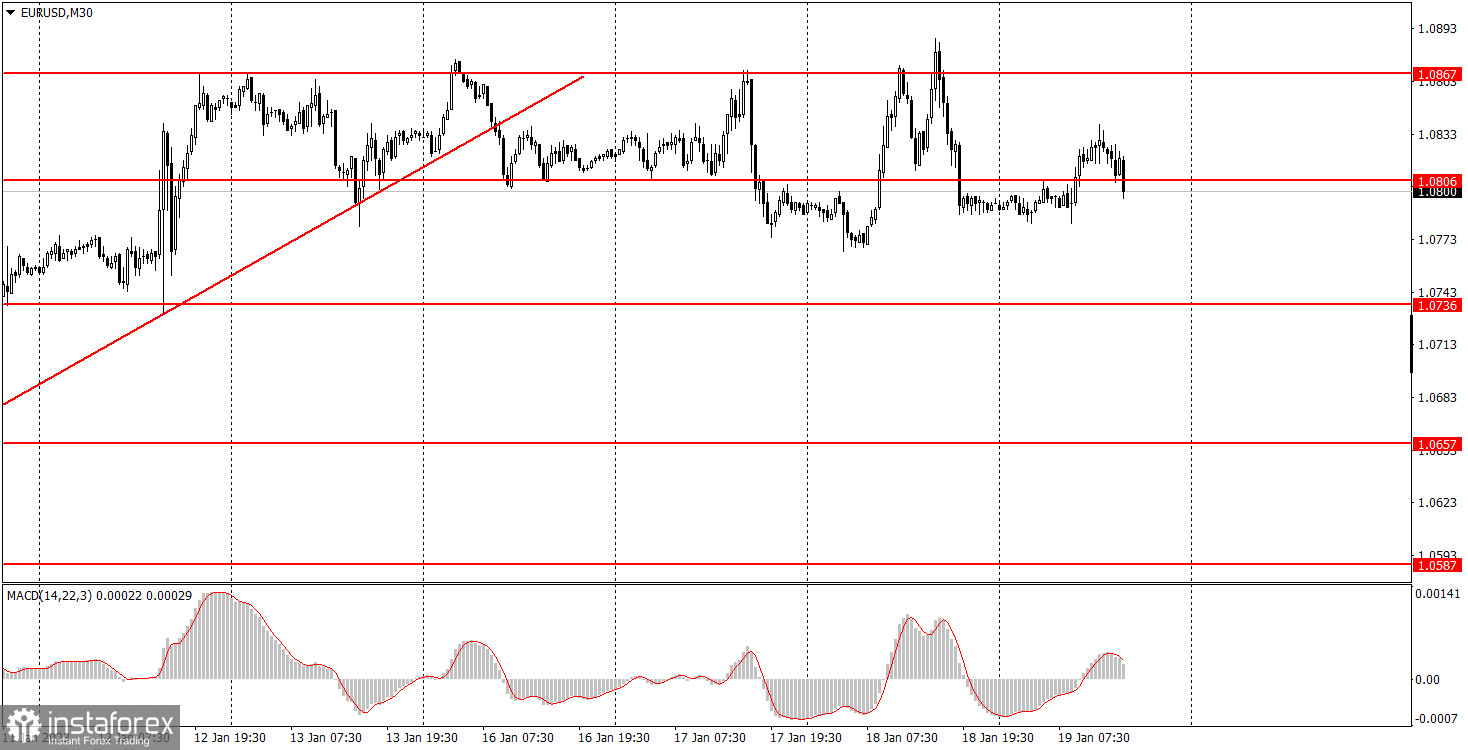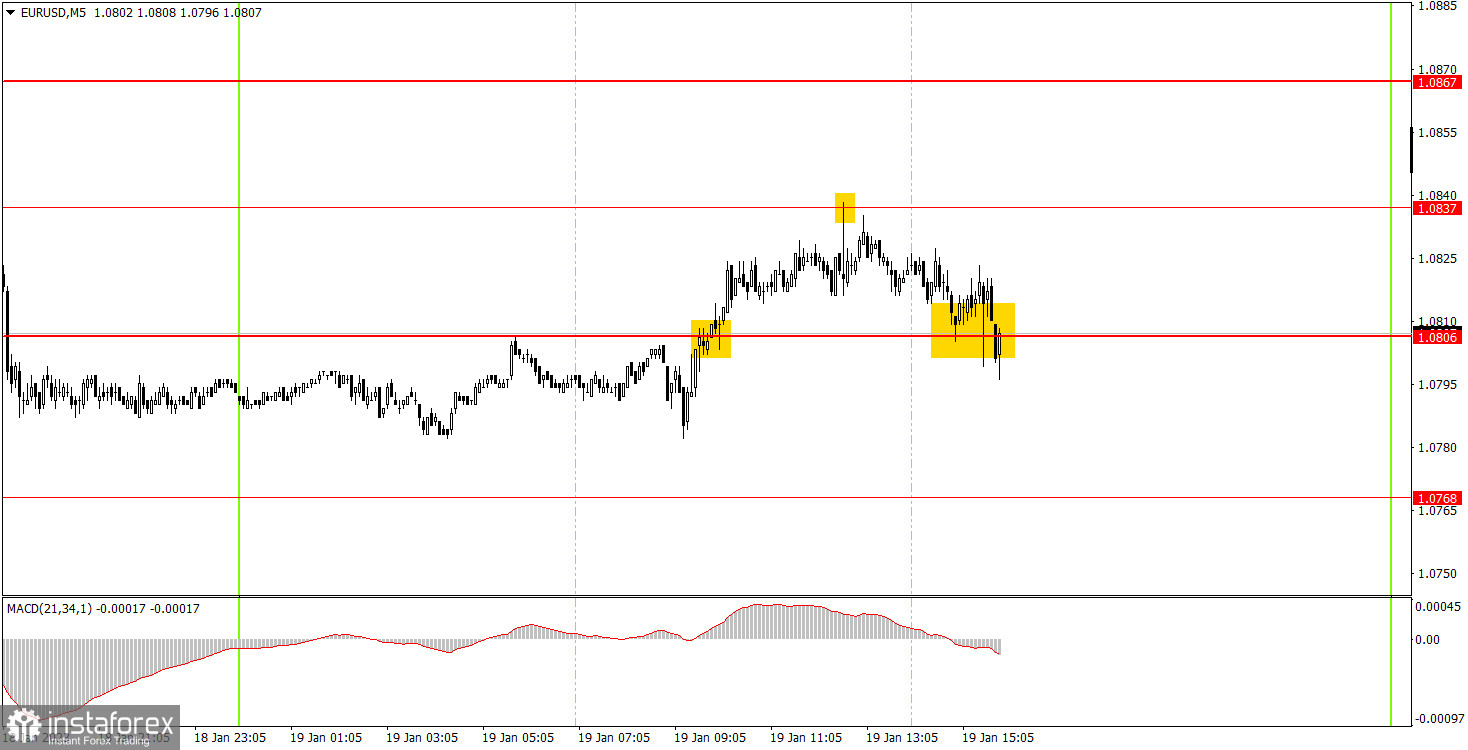Analyzing Thursday's trades:
EUR/USD on 30M chart

The euro's movements on Thursday were unclear. Fundamental and macroeconomic backgrounds were almost absent, but there was still a speech from European Central Bank President Christine Lagarde, in which she promised the ECB will stay the course of rate hikes. Thus, the euro had formal grounds for growth on Thursday but it didn't rise at all. Volatility declined sharply and there was virtually no movement during the day. The pair has been moving sideways for five consecutive days and it could not cross 1.0867, which kept the pair from rising further. So, maybe it is the time for a bearish correction, which we have been waiting for. Reminder: four days ago, the pair settled below the ascending trend line, which by itself means a change of the trend. The pound simply ignored a similar signal, but the euro shows the rudiments of a desire to move down at least a little bit.
EUR/USD on M5 chart

Despite the fact that there were virtually no movements, several signals were formed during the day. First, the pair settled above 1.0806, and then it reached 1.0837, which was very close. It was impossible to get much profit on this deal, but 10 points of profit is better than nothing. The sell signal at 1.0837 should have worked too, but the price went back to 1.0806. Therefore, you could gain another 10 points of profit. Further it became clear that there would be no movement during the day, so if novice traders wanted to continue the "pipsing", they could do so, as signals continued to be formed due to the proximity of the levels. We think it's better to wait for a stronger movement.
Trading tips on Friday:
The pair maintains the uptrend on the 30-minute chart, despite crossing the trend line. As we can see, neither four bounces from 1.0867, nor crossing 1.0806 can change the market sentiment to bearish yet. Therefore, each new consolidation or rebound from these levels can be regarded as a sell signal, but we should be very careful. On the 5-minute chart, it is recommended to trade at the levels 1.0657-1.0668, 1.0697, 1.0736, 1.0768, 1.0806, 1.0837, 1.0905, 1.0923-1.0933, 1.0966, 1.0989. In the EU, Lagarde will deliver another speech on Friday. Meanwhile, several heads of the Federal Reserve will do the same in the U.S. However, Lagarde already said everything, and as you can see, there was no special market reaction to her speech. No important reports scheduled for tomorrow.
Basic rules of the trading system:
1) The strength of the signal is determined by the time it took the signal to form (a rebound or a breakout of the level). The quicker it is formed, the stronger the signal is.
2) If two or more positions were opened near a certain level based on a false signal (which did not trigger a Take Profit or test the nearest target level), then all subsequent signals at this level should be ignored.
3) When trading flat, a pair can form multiple false signals or not form them at all. In any case, it is better to stop trading at the first sign of a flat movement.
4) Trades should be opened in the period between the start of the European session and the middle of the US trading hours when all positions must be closed manually.
5) You can trade using signals from the MACD indicator on the 30-minute time frame only amid strong volatility and a clear trend that should be confirmed by a trendline or a trend channel.
6) If two levels are located too close to each other (from 5 to 15 pips), they should be considered support and resistance levels.
On the chart:
Support and Resistance levels are the levels that serve as targets when buying or selling the pair. You can place Take Profit near these levels.
Red lines are channels or trend lines that display the current trend and show in which direction it is better to trade now.
The MACD indicator (14, 22, and 3) consists of a histogram and a signal line. When they cross, this is a signal to enter the market. It is recommended to use this indicator in combination with trend patterns (channels and trendlines).
Important announcements and economic reports that can be found on the economic calendar can seriously influence the trajectory of a currency pair. Therefore, at the time of their release, we recommend trading as carefully as possible or exiting the market in order to avoid sharp price fluctuations.
Beginners on Forex should remember that not every single trade has to be profitable. The development of a clear strategy and money management is the key to success in trading over a long period of time.
 English
English 
 Русский
Русский Bahasa Indonesia
Bahasa Indonesia Bahasa Malay
Bahasa Malay ไทย
ไทย Español
Español Deutsch
Deutsch Български
Български Français
Français Tiếng Việt
Tiếng Việt 中文
中文 বাংলা
বাংলা हिन्दी
हिन्दी Čeština
Čeština Українська
Українська Română
Română

